Lead Smart
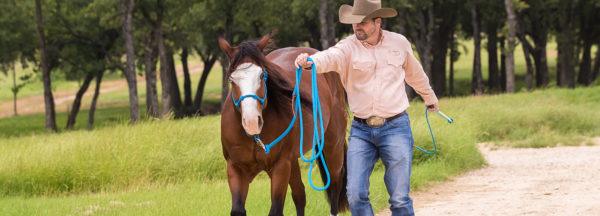
Be a Leader
If you’re like most horse owners, the time you have to spend with your horse is limited and valuable, which means that you need to make every second count when you’re interacting with him. One opportunity people often overlook is leading their horse to and from the pasture. If you’re with your horse, you might as well be teaching him something!
1. If this scenario looks familiar, you need to step up your game. Rather than letting your horse drag behind you and snatch grass, be a leader. Get his feet moving forwards, backwards, left and right to get him to tune in to you and to get in the right mind frame for your lesson ahead. Or, use the time to simply brush-up on the groundwork exercises you’ve taught him. Remember what I always say: Horses are nothing but maintenance with legs. You may have done a great job teaching your horse the Fundamentals exercises and have earned his respect and trust, but if you don’t remind him of those lessons, he’ll soon forget them. In order for the horse to continue to use the thinking side of his brain and remain respectful, you have to constantly remind him by moving his feet forwards, backwards, left and right and always rewarding the slightest try. Horses do not stay the same. Every day, they either get a little better or a little worse, depending on your interaction with them.
2. I love to back my horses every chance I get, and that includes when I’m taking them to and from the pasture. The better your horse backs up, the more responsive he will be in everything else you ask him to do. Not only should you back your horse up, but you should make it a point to switch up the ways in which you ask him to back. We teach four different types of backing up methods in the Fundamentals Series—Tap the Air; Wiggle, Wave, Walk and Whack; Marching; and Steady Pressure—the Outback Exercise in the Intermediate Series, and Backing Angles; Backing Circles; and Backing Serpentines in the Advanced Series. The more variety you add to your training, the more interested and content your horse will be.

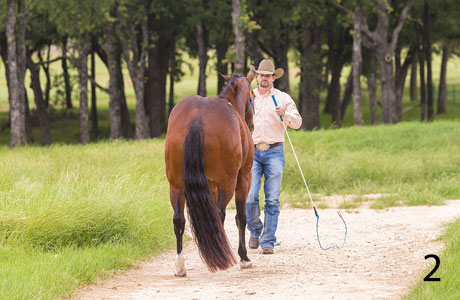
3. When it comes to getting a horse from point A to point B, the C-Pattern is a handy exercise. It’s especially great to do with horses that are fresh because it gets their feet moving and includes a lot of changes of direction, which encourages the horse to use the thinking side of his brain. It’s also useful to use with horses that have a tendency to rush ahead of you and drag you to where you’re going. Because you’re asking the horse to move from one side of you to the other, yield his hindquarters and stay out of your personal space all while you’re on the move, it quickly reinforces your leadership role.
4. Horses aren’t born knowing how to be led. You have to teach them how to lead correctly. I use the Leading Beside exercise in the Fundamentals Series to teach horses to respect my space, pay attention to my cues and to take direction from me rather than pushing into my space and trying to lead me. This is a great exercise to practice while going to and from the pasture to keep your horse on his toes and to double-check his responsiveness. It’s especially useful with a lazier type of horse that has a tendency to want to drag behind you. The exercise reinforces to the horse that anytime he feels pressure from the halter behind his ears, he should immediately come forward off it rather than pull and lean against it.
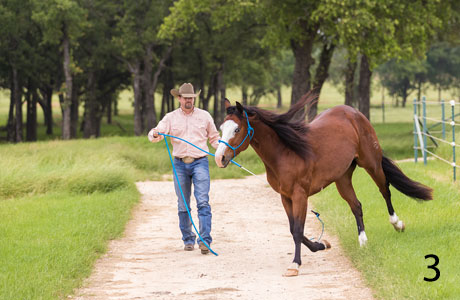

5. If my horse spooks at something or gets startled, I address the issue then and there, even if it puts me behind schedule for a training session or I have somewhere else to be. Your horse shying at a plastic bag hanging on a fence might not seem like a big deal today, but if it’s not addressed, it’ll soon turn into him bolting at the sight of a bag. Don’t let the little things slip. What starts out as a minor problem can quickly escalate into a full-blown, dangerous situation. My go-to exercise to use when my horse spooks at something when I’m on the ground is the Sending Exercise. The Sending Exercise is found in the Fundamentals Series, and using it, we keep our feet still while the horse walks or trots in an arc between us and an object. At the end of each half circle, he yields his hindquarters and turns to face us with two eyes before we send him back the other way. The more frightened the horse is of the object, the farther away from it you’ll have to start. You’ll gradually close the gap until you can send the horse right beside the object without him reacting to it. Then let him rest and get his air back as he stands right beside it.
6. Just as much as I want my horses to lead respectfully beside me, I want them to lead well behind me. I hate feeling as if I’m dragging a horse behind me like a stolen dog. If I walk off or pick up my pace, I want my horse to be right there with me, coming off the halter pressure but staying a respectful distance away from me, not breathing down my neck. To teach a horse to lead behind me, I use the Intermediate exercise Leading Behind. It teaches a pushy horse that wants to run over top of you to respect your space, and it gets a lazy horse that drags behind you to come forward off light halter pressure. I find that this exercise works best when you do it at random times when the horse is least expecting it. It’s a test to see how quick he is to come off the halter pressure and follow you. When you’re leading him to or from the pasture, jog off and see what he does. You’ll notice that if you practice the exercise when the horse is least expecting it, he’ll start to pay more attention to you because he knows that at any time you might make his feet move.
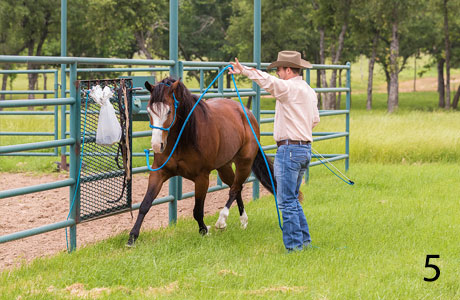
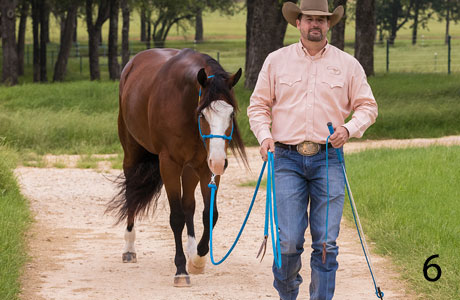
In this article, Clinton is working with his broodmare Pandora. Pandora, registered as Lipstick N Whizkey, is by Gunners Special Nite out of Princess In Diamonds. To learn more about Clinton’s performance horse program, visit clintonandersonperformancehorses.com.

